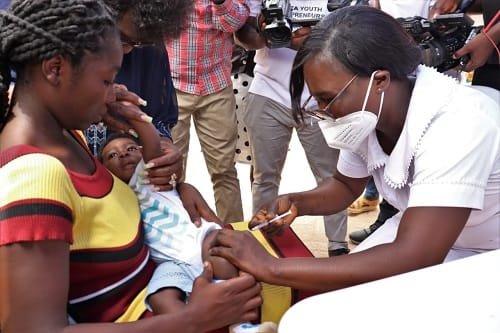The newly inaugurated Minister of Health, Muhammad Ali Pate, has his job cut out for him, if the country is to experience a turnaround in this sector. Jumoke Olasunkanmi lists some issues the needs to address to achieve this.
Ranked 163 out of 191 countries with the poorest healthcare services globally by the World Health Organisation’s Health System Ranking in 2021, the state of healthcare in Nigeria does not inspire hope.
But if the assurances constantly made by President Bola Ahmed Tinubu are anything to go by, the following sectors must, as a matter of urgency, be given expedited attention.

1.Restoration Of Primary Health Centres (PHCs)
PHCs serve as the first level of contact for members of a community for non-emergency and preventive health issues. It should, therefore, be the first option when seeking healthcare services to avoid overcrowding tertiary healthcare facilities. However, the deplorable state of PHCs across the country is a pointer to why many Nigerians seek alternative healthcare services from unscrupulous sources – a dangerous practice that is on the rise.
For healthcare to be accessible to all Nigerians, primary health centres which were established to bring healthcare services closer to the people should not be far away.
According to the former Minister for Science and Technology and Minister of Health, Senator Olorunnimbe Mamora, there are 30,000 PHCs in the country presently, but only 10 percent of these health centres are functional.

With health centres far away or non-functional due to neglect, equipment and manpower deficit, many Nigerians are forced to look elsewhere for treatment. African Health Report (AHR) spoke with Miss Onyekachi Nwachukwu, a resident of Agbara, Ogun State, who disclosed that she relies on herbal concoctions, popularly known as agbo and sometimes, a visit to the local pharmacy when she is sick because public hospitals are too far from her house.
“I stay in Agbara and hospitals are quite far from my house. The last time I had malaria, I went to a pharmacy to complain and was given drugs, I also complimented the drugs with herbal concoction,” she said.
According to a handbook – the Minimum Standards for Primary Healthcare in Nigeria – published by the National Primary Health Care Development Agency (NPHCDA), every PHC should have at least 24 staff, including a doctor, nurses, community health extension workers (CHEW), a pharmacy technician, medical records officer, among others.
The handbook also recommends that PHCs have at least 13 rooms, a clean water source and an alternate power source.

A visit to AMAC PHC in Lugbe, Abuja, tells a different story. AHR reporter visited the health centre after a bout of fever, and after paying N500 for a family card and consultation with the doctor who said he had to begin treatment though she had to wait till the following day to carry out the prescribed test for diagnosis as the lab had closed for the day.
She was then given intravenous fluid and injections by the only nurse on duty who went about her duty without gloves or a cannula.

AHR’s reporter also shared the ward with two other patients- a male and a nine-year-old girl, because the clinic had only one ward. At about 8 pm that day, power went off and the nurse brought a dimly lit lamp to the ward as there was no alternate power source and patients had to rely on their phones’ flashlights.
The following day, a blood sample was taken by a lab technician who had no gloves on. At this point, it was obvious that the healthcare centre, like many others in the country, was not just understaffed, it was also poorly equipped.
Functional PHCs will also help solve the problem of maternal and child mortality; according to WHO. Nigeria currently has the second-highest maternal and child mortality rate globally with 540 out of 1000 women and children dead in 2020 alone.

With functional and accessible PHCs, immunisations and antenatal care will improve and maternal mortality and deaths can be avoided.
2. Universal Health Coverage
A 2023 survey by NOI Polls showed that only 17 percent of the country’ population are insured and 75 percent of this figure are covered by the National Health Insurance Scheme (NHIS). The survey revealed that 80 percent of the respondents rely on out-of-pocket payment to offset health bills, it also showed that awareness of the NHIS is low as 49 percent of people who pay out of pocket were not aware of the scheme.

Since majority of the populace are uninsured, they rely on out-of-pocket expenditure to foot medical bills. Data from the World Bank pegged out-of-pocket health expenditure in Nigeria at 74.7 percent in 2020, but with 133 million people in multidimensional poverty, according to the National Bureau of Statistics, out-of-pocket health expenditure affects the ability of households and individuals’ basic healthcare needs and further impoverish them.
In the case of the AHR reporter cited earlier, every other patient at AMAC health centre, including her, paid for everything used for treatment at the public health centre out of pocket; from registration, tests, injections, intravenous drips and prescribed medicines.
These expenses push more and more Nigerians away from conventional medicine towards unconventional modes of treatment, thereby increasing the already high mortality rate.
The Minister of Health needs to address this as a matter of urgency by ensuring mandatory health insurance for Nigerians in public and private sectors.
3. Pharma Sector Agenda
Nigeria’s pharmaceutical sector is one of the least harnessed areas of healthcare the Nigerian government is yet to fully tap into, considering the return on investment this would bring into the country. Many regard it as a multi-billion dollar investment Nigeria which hasn’t been harnessed.
This can be done through local production of essential medicines. Nigeria’s National Drug Policy recommends that Nigeria should produce at least two-thirds of its essential drug needs locally. This target, however, has not been achieved as Nigeria produces only about a third of the nation’s drug requirements.

While significant effort has been made by government’s partnership with local companies to improve local capacity in the production of vaccines and biologicals, the Minister and other stakeholders involved still need to come up with a robust and comprehensive incentive framework will also expedite local production of essential medicines. To achieve this, a proactive strategy which will be adopted to ensure that this development results in sustainable access to safe, affordable and high-quality healthcare.
To encourage locally produced drugs, government should prioritise and patronise these medications as stipulated by the Executive Order Number Three (section 4F), which specifically directs that locally produced drugs and medicaments are given priority in procurement of drugs by the public sector.
Medicines – locally produced and imported – should require robust and comprehensive quality checks to ensure safety and improve the quality of medicines in the country. This can be done through regulations, Good Manufacturing Practices in medicines and other pharmaceutical productions and surveillance of imported drugs.
4. National Mental Health Agenda
In 2019, WHO stated that 1 in 8 people are living with a mental health disorder. Their 2020 data also revealed that 20 million Nigerians suffer from varying degrees of mental illness without access to psychiatric care. In 2022, Taiwo Obindo, President of the Association of Psychiatrists in Nigeria, tagged this figure at 60 million.
Mental health was ranked the fourth leading cause of global disease burden and estimated to hit second by 2020, lagging behind only ischemic heart diseases.
Despite being an alarming public health issue due to the large population affected, studies have shown that mental disorder is not taken as a priority, especially in low and middle-income countries like Nigeria, where it is highly misunderstood.

Out of the 60 million Nigerians estimated to have one form of mental disorder or the other, only about 20 per cent of persons in such category seem to have the obvious forms of it, which includes what the ordinary Nigerian refers to as madness, schizophrenia, and perhaps, extreme case of drug or alcohol addiction; a reason that has largely made mental disorder in the remaining 80 per cent or 48 million Nigerians ignored or poorly understood.
WHO data has shown that although treatments are available, nearly two-thirds of people with a known mental disorder never get help from a health professional as stigma, ignorance, discrimination and neglect continue to prevent care and treatment from reaching majority of people with mental disorders.
To address this, the Minister should ensure that deliberate effort are directed towards this growing concern by appointing a National Mental Health Czar with the sole purpose of pushing a National Mental Health Agenda for the country, especially with the spate of mental health issues in the country; as well as reviewing the present National Mental Health Policy to reflect current needs.
Mental Health Policy on the practice of psychiatry reviewed in 2013 is yet to be fully implemented. The policy recommends the integration of mental health into primary healthcare. As such, there should be full integration of mental care into primary healthcare with front-line staff being able to identify and treat common mental disorders such as anxiety, stress, depression and sleep problems using resources such as the mental health Gap Action Programme (mhGAP) tool.
Fully functioning psychiatric departments that can treat most mental disorders such as schizophrenia and bipolar affective disorder should be established in all general hospitals in the country and preventive care given utmost priority. Suitable work-life balance and appropriate lifestyle choices should be promoted; in addition to public education through various educative programmes, media engagements and suicide prevention activities such as education and managing suicide hotspots in the country.
5. Healthcare Financing Template
Nigeria currently has one of the poorest healthcare financing models in the world.
In 2023, N1.17 trillion was allocated to the health sector, which is just 5.75 percent of the total budget, less than the 15 percent recommended by the African Union. Out of this sum, only N47.64 billion was allocated to the Basic Health Care Provision Fund (BHCPF), 13.61 percent lesser than 2018’s N51.15 billion. With a population of 223.8 million people, the healthcare allocation per person is less than N6000.
With the country presently spending less on healthcare than nearly every country in the world – a reflection of its under-prioritisation of the sector, health spending has become dominated by out-of-pocket expenditures with its well-known impoverishing effects, especially since the majority of those who purchase healthcare in the country are poor Nigerians.
The health sector is, therefore, in need of urgent reforms, some of which include leveraging financing from outside the public health sector and institutional reforms such as the development of state social health insurance schemes by state governments which mobilise additional financial resources from states, pools resources, and is a veritable strategic purchasing mechanism. The Primary Healthcare Under One Roof (PHCUOR), which emphasises the integration of primary care services and promotes governance and accountability for the delivery of primary care is another veritable strategic purchasing mechanism.



